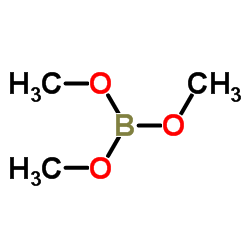Gas phase reactions of trimethyl borate with phosphates and their non-covalent complexes.
Scott Gronert, Richard A J O'Hair
Index: J. Am. Soc. Mass Spectrom. 13(9) , 1088-98, (2002)
Full Text: HTML
Abstract
Using a quadrupole ion trap mass spectrometer, trimethyl borate was allowed to react with dihydrogen phosphate, deprotonated O-phosphoserine, and a set of hydrogen bonded complexes involving dihydrogen phosphate and neutral acids (phosphoric acid, acetic acid, serine, and O-phosphoserine). The reactions show a consistent pattern in which the initial attack leads to addition with the loss of one or two CH3OH molecules. Collision-activated dissociation (CAD) experiments on the reaction products generally lead to the loss of an additional CH3OH molecule. In no case is a partner from the original hydrogen-bonded complex lost. The results indicate that the reactions lead to structures where the phosphate and its complex partner are covalently bound to the boron. For each of the reactions, rate constants were determined. In the course of CAD experiments (up to MS5), several novel borophosphate structures were identified. The work is supported by ab initio calculations on selected species.
Related Compounds
| Structure | Name/CAS No. | Molecular Formula | Articles |
|---|---|---|---|
 |
Trimethyl borate
CAS:121-43-7 |
C3H9BO3 |
|
Selective formation of organo, organo-aqueous, and hydro gel...
2015-07-07 [Soft Matter 11 , 5060-6, (2015)] |
|
Chloromethyl chlorosulfate: a new, catalytic method of prepa...
2004-05-21 [Org. Biomol. Chem. 2 , 1554, (2004)] |
|
Identification of epoxide functionalities in protonated mono...
2012-01-01 [J. Am. Soc. Mass Spectrom. 23(1) , 12-22, (2012)] |
|
Identification of the carboxylic acid functionality by using...
2008-05-01 [Anal. Chem. 80(9) , 3416-21, (2008)] |
|
Borinium adduct ion formation with barbiturates in a quadrup...
1996-04-01 [J. Mass Spectrom. 31(4) , 403-10, (1996)] |